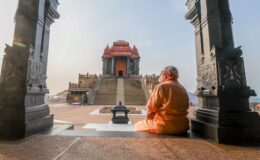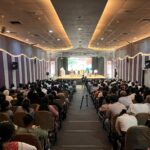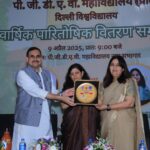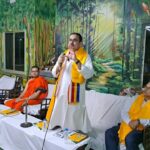IN MEMORY OF ABHEDANANDA
- By : Anirban Ganguly
- Category : Articles
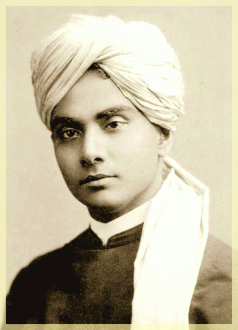
This year as we commemorate the 150th birth anniversary of Swami Abhedananda, we must meditate on the spiritual nationalist’s epochal contribution to India’s selfhood. Such a rekindling of interest is imperative for the success of our national quest for an integral self-reliance
This year and 2017 mark crucial centennial and sesquicentennial landmarks in the evolution of the Bharatiya self and self-consciousness. In fact since 2013 we have entered such a phase which gives occasion to commemorate those lives which made decisive interventions in the definition and renewed expression of the Bharatiya psyche, its world view and its essentiality.
The year 2013 marked the 150th year of Swami Vivekananda’s eternal birth. Then, 2014, apart from the political sea-change that it announced, was also the centenary of the Mother’s (Mirra Alfassa) first visit to India and her first meeting with Sri Aurobindo in Puducherry (then Pondicherry). It was a meeting that inaugurated a new era in India’s unending spiritual evolution.
The year 2014 was also the centenary of that seminal treatise, Radha Kumud Mookerjee’s The Fundamental Unity of India, which asserted, for the first time, in modern idioms and in response to colonial rejection of Indian unity, the thesis of India’s cultural unity and articulated cultural nationalism.
This year marks the birth centenary year of Pandit Deendayal Upadhyaya, a visionary nationalist who, through his politics and political philosophy, gave a mighty push that gradually re-oriented the course of post-independence India’s political march. While 2017 herald’s the 150th year of Sister Nivedita’s birth, that idealist who wished to serve India till her last breath, this year herald’s the 150th birth anniversary of another epochal mind — a spiritual nationalist who was a monk and a revolutionary at the same time.
Kali Prasad Chandra (Swami Abhedananda) was born on October 2,1866, in Calcutta and at the age of 18, a certain restlessness brought him to Sri Ramakrishna. Abhedananda’s life was marked out by a spirit of directness, of independence, of an unwavering goal of achieving spiritual mastery, a towering intellectual capacity and an intrinsic and inseparable identity with the spirit and soul of India.
His early years with the master saw Abhedananda rapidly ascend the ladder of yogic realisation, the master once told him, “I consider you to be one of the most intelligent of the boys.” The early days at Baranagore, after the master’s samadhi saw Abhedananda engrossed, like Naren, in “study and meditation.” “Kali”, observed Vivekananda “was the most studious of us all. He even surpassed me in this respect.”
Indeed Abhedananda’s life was a multi-dimensional one. While his chief identity and driving force was that of a direct disciple of Sri Ramakrishna, Abhedananda was also an interpreter of Indian traditions and knowledge, a defender of India’s civilisational achievements and high-water marks — he combined in himself the philosopher and the historian — an articulate and consistent advocate of its freedom and a dreamer of its self-reliant future — each of these blended and enmeshed seamlessly with the other.
This passion for India, this obsession for its greatness, this pre-occupation with its state of bondage, Abhedananda, like his “guru-bhai”, Vivekananda, absorbed from the soil and the air of India. Before he came onto the world scene, Abhedananda too “travelled throughout the length and breadth of Hindusthan, from the Himalayas down to Rameshwaram and from Jagannath to Dwarka, barefooted, without touching money, without thinking of the morrow and with one blanket as his bed and garment.”
It was this phase of internalising India that saw him later, in 1905, in the peak of the Swadeshi movement in India; deliver his “Brooklyn lectures” at the Brooklyn Institute of Arts and Sciences, in New York on India and her people. As one of his outstanding biographers, Moni Bagchi noted, “The patriot emerged out of the preacher and since, 1905, he fought almost single-handed with unabated zeal and undaunted heart for the cause of India in the face of vehement opposition, bitter criticism, racial prejudice and the sectarian jealousy then prevalent in America.”
The lectures were compiled and published in 1906 by the Vedanta Society of New York as, “India and Her People” and was dedicated “To the People of India with deep fellow feelings and earnest prayers for the restoration of their ancient glory and national freedom.” The book, though promptly proscribed by the colonial Government in India, became, along with Vivekananda’s “Lectures from Colombo to Almora”, the driving gospel in revolutionary circles.
This same attachment of his to civilisational and eternal India found utterance in Abhedananda’s philosophical and religious treatises as when he wrote in the introduction to his seminal study “Bhagavad Gita — the Divine Message”, “Waves of conquest and religious fanaticism have come to India from the West, one after another, and have swept away by their tremendous on-rush millions and millions of lives and the most glorious spiritual monuments which this country had produced, but still the marvellous ideal and spiritual kingdom of Sri Krishna have remained for ages firm as the unshakeable Himalayas, defying their strength and destructive powers.”
After a quarter of a century stay in the West, Abhedananda returned to an India, that it was in the throes of the struggle for freedom and he took “immense pain to study and understand the problems of his countrymen.” He advocated industrial and scientific self-reliance for India. His Jamshedpur lectures of 1922, for example, give an insight into his thinking then. In one such on “progressive Hinduism”, he exhorted his countrymen thus, “You must encourage the industry of your own country. I have a great desire to have an ideal Institute of national industry established in India. One Tata project is not enough for India. She must have other factories in other parts of India…You must work or perish.”
In course of this period, one of his most crucial and active one, as a spiritual nationalist and a patriot-monk, a number of leaders came in touch with Abhedananda, starting with Deshbandhu CR Das who had struck a particularly deep bond with him.
In 1925 he had interesting meeting with Mahatma Gandhi in Darjeeling. “You are doing the work started by Ramakrishna and Vivekananda”, Abhedananda told the Mahatma, “in the lines of removing untouchability and in encouraging cottage industries. Therefore, I bring you blessings. You know that though a high caste Brahmin by birth, the master once prayed to the divine mother to take away egoism or ahamkara from his mind that a Brahmin is superior to sweeper on account of his birth to enable him to realise that the atman (soul) of a sweeper is just as divine as that of a high caste Brahmin; and in order to realise this grand truth he went to the doors of a sweeper and wiped the dirt of his door with his flowing long hair which he then had on his head. Thus Ramakrishna set an example of the removal of untouchability which is the higher religion of this age.”
When Subhas Chandra Bose came calling, upon being elected Congress president, an ailing and confined Abhedananda rose up and embracing Subhas, blessed him with the words, “Be thou victorious”, thus putting his seal behind Subhas’s actions for freeing India.
In this 150th year of his birth thus, we would do well to commemorate and to meditate on Swami Abhedananda’s epochal contribution to India’s selfhood, a rekindling of that interest is imperative for the success of our national quest for an integral self-reliance.



